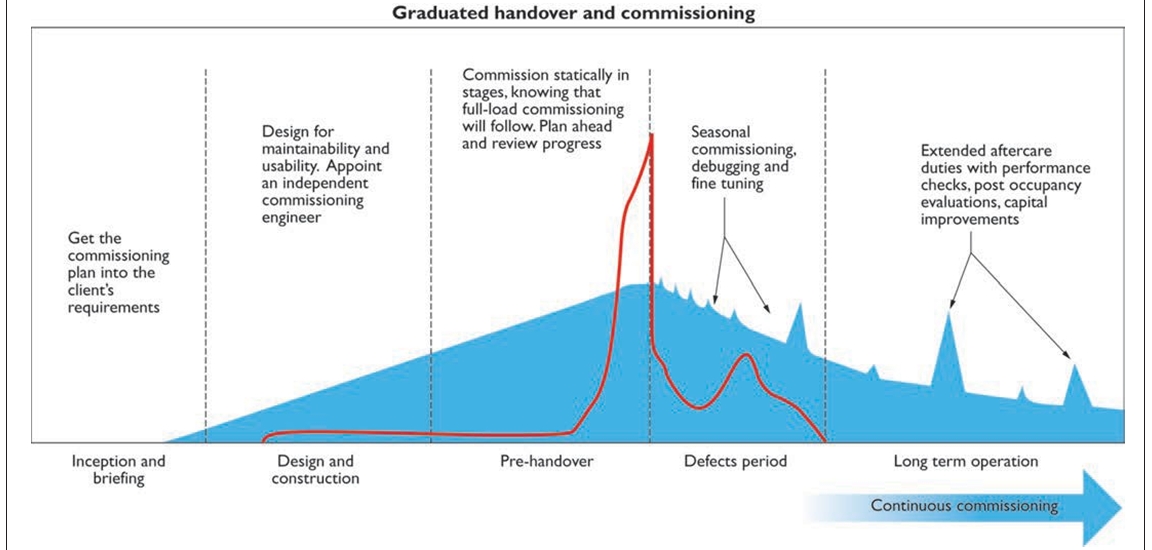Planning the commissioning of buildings
The best commissioning process is one that is planned from the project’s very inception. Designing in the ability to commission systems properly from the outset can provide huge benefits, especially on cost and performance.
Essentially, good commissioning is the difference between providing a feature that works, and one where its functionality for the end-users has been verified. For example, it’s one thing to include a meter or valve in a design, and another to install it in an easily accessible place. (Even in the exemplar buildings in the Carbon Trust’s LCBP research, installation errors were still found, such as sub-meters installed at toe level.)
Several projects in the LCBP programme had appointed an independent commissioning specialist to oversee the whole process, from design through construction and, vitally, during handover. The specialist in these cases was appointed by the main contractor.
In a parallel initiative, the Commissioning Specialists Association (CSA) is recommending that clients appoint a commissioning verification engineer to monitor the process as the ‘client’s friend’. This sits comfortably with practices followed by the more successful LCBP projects. The common factor in many cases was where a person or organisation was involved continuously throughout the design and construction process, and on into occupation.
While a commissioning manager will usually be appointed by the main contractor, they can be appointed directly by the client. This might be the case where the client is an owner-operator, such as a university, and/or has a vested interest in the commissioning being carried out correctly at the early stages to reduce long-term running costs.
LCBP projects that were run by a knowledgeable, interested client, and where a commissioning consultant had been appointed to oversee the process enjoyed a building with better performance and fewer ongoing defects. Others, where there was no follow through from those involved during the construction, tended to suffer performance penalities. These penalties were usually seen in energy consumption being much higher than the design prediction, and low levels of occupant satisfaction with comfort factors, such as temperature, air quality and noise.
Above: The new professional’s view of commissioning overlain on the old leave-it-to-the- last-minute approach to commissioning. The commissioning plan is started at the early stage of the project, and populated with detail as it becomes available. This approach calls on project professionals to plan early, reality-check as they go along, prepare fully for handover, and follow through after occupation to fine-tune and resolve issues as they emerge.
Above: How not to install an electrical sub-meter: at toe level on the distribution board. This happened on each floor of an office block, studied by the Carbon Trust. It might not have mattered had the BMS been set up to read the meter pulses correctly. It wasn’t. The BMS was found to miss around 60 per cent of the meter pulses. Sadly it’s not unusual.
This article originally appeared in Delta T Magazine May 2011, written by BSRIA’s James Parker. It was posted here by --BSRIA 08:31, 26 November 2014 (UTC).
[edit] Related articles on Designing Buildings Wiki
- At your services - What to expect during commissioning.
- Client commissioning.
- Commissioning.
- Commissioning documents.
- Commissioning notice.
- Commissioning plan.
- Commissioning v testing.
- Corrosion in heating and cooling systems.
- Handover to client.
- Initial commissioning case studies.
- Inspection.
- Migration strategy.
- Practical completion.
- Seasonal and continuous commissioning.
- Soft landings.
- Specialist commissioning manager.
Featured articles and news
Infrastructure that connect the physical and digital domains.
Harnessing robotics and AI in challenging environments
The key to nuclear decommissioning and fusion engineering.
BSRIA announces Lisa Ashworth as new CEO
Tasked with furthering BSRIA’s impressive growth ambitions.
Public buildings get half a million energy efficiency boost
£557 million to switch to cleaner heating and save on energy.
CIOB launches pre-election manifesto
Outlining potential future policies for the next government.
Grenfell Tower Inquiry announcement
Phase 2 hearings come to a close and the final report due in September.
Progress from Parts L, F and O: A whitepaper, one year on.
A replicated study to understand the opinion of practitioners.
ECA announces new president 2024
Electrical engineer and business leader Stuart Smith.
A distinct type of countryside that should be celebrated.
Should Part O be extended to existing buildings?
EAC brands heatwave adaptation a missed opportunity.
Definition of Statutory in workplace and facilities management
Established by IWFM, BESA, CIBSE and BSRIA.
Tackling the transition from traditional heating systems
59% lack the necessary information and confidence to switch.
The general election and the construction industry
As PM, Rishi Sunak announces July 4 date for an election.
Eco apprenticeships continue help grow green workforce
A year after being recognised at the King's coronation.
Permitted development rights for agricultural buildings
The changes coming into effect as of May 21, 2024.
























